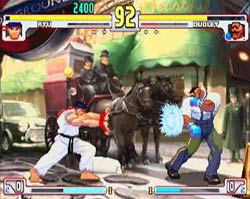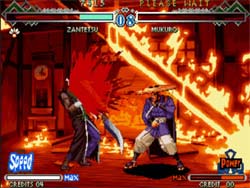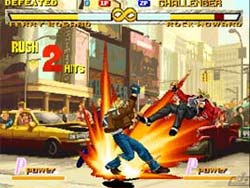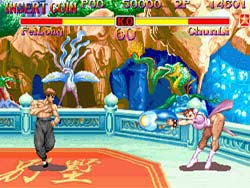Dreamcast 2D Fighting Game Library
 The Sega Saturn was a phenomenal platform for 2D fighters, but many gamers would not have expected that the Dreamcast would follow in the Saturn’s footsteps so well.
The Sega Saturn was a phenomenal platform for 2D fighters, but many gamers would not have expected that the Dreamcast would follow in the Saturn’s footsteps so well.
The Dreamcast was strongly supported by both Capcom and SNK. It received many of the best fighting games before the PS2, XBox, and Gamecube. There are also a number of great games (mostly SNKs) that did not get a port to the newer console or the ports were inferior.
While the Dreamcast’s standard controller is pretty awkward for 2D fighters (as opposed the blissful Saturn controller), the “official” Agetec arcade stick is very well built and should be treasured by any fighter fan.
 Street Fighter 3: Double Impact
Street Fighter 3: Double Impact
Street Fighter 3: Third Strike
Much like the first Street Fighter Alpha game, Street Fighter 3 initially threw off some Capcom fanboys because of its new fighting style and almost completely new roster of characters.
However, those of who gave the game a chance (especially once the later installments came along) were treated with a pleasant surprise of a polished fighting system, unique fighters, and wonderful animation.
The Dreamcast was actually treated to all three versions of Street Fighter 3. The first two installments came packaged on Street Fighter 3: Dual Strike, but were greatly overlooked. It wasn’t until Third Strike was released that Street Fighter 3 started to get the respect it deserved.
Among other great moves like Hyper Arts and Combos, Street Fighter 3 introduced the Parry system, which when used successfully, will interrupt the opponent’s attack and open him/her up to your best efforts.. Each of these fighting elements contributes to the heavy strategy element found in the game.
Third Strike also included a grading system that rated your fighting skills based on your style and strategy. You’ll feel that it’s not just the win that counts, but also how you did it.
Review of Street Fighter 3: Double Impact
Review of Street Fighter 3: Third Strike
 Street Fighter Alpha 3
Street Fighter Alpha 3
Gamers love Street Fighter and large character rosters, so Street Fighter Alpha 3 received a great deal of praise by bringing a slew of the characters from Street Fighter 2 in with the already impressive lineup of Street Fighter Alpha 2 characters in addition to some new players.
Alpha 3 had a wonderful blend of fresh sprites, great combos, and a fighting system that was easy to play, but difficult to master. It also allowed great flexibility in choosing your fighting style.
While the Dreamcast port wasn’t technically arcade perfect, it did have a wealth of extra features and play modes. Overall, its basically a requirement for Dreamcast owners that are interested in fighting games.
Review of Street Fighter Alpha 3
 The Last Blade 2
The Last Blade 2
Many SNK fans consider the Last Blade series to be what Samurai Shodown 3 and 4 should have been. It’s gameplay can be best compared to the later Samurai Shodowns and with some elements of the King of Fighters series, with the end result being a remarkably smooth and enjoyable fighting engine.
There are three modes of play, Power, Speed and EX (a merging of the first two) which make for substantial variety in gameplay. There is also a great deal of depth to the game, aided further by the addition of the Repel button, which is somewhat similar to Street Fighter 3’s parry system.
Every single frame of animation appears to be included in the Dreamcast version and the animations are smooth and fluid. Keep in mind that Last Blade games have low-key visuals. Don’t expect huge, flashy supers and uber-high hit combos. Instead you’ll find moves of a simple but pleasing visual flair.
Review of The Last Blade 2
 Fatal Fury Mark of the Wolves
Fatal Fury Mark of the Wolves
Possibly the best SNK fighter ever, Fatal Fury (Garow): Mark of the Wolves takes place well after the events of the previous games in the series. Because of this and the modernized fighting system is is basically SNK’s counterpart to Street Fighter 3: Third Strike.
Like Street Fighter 3, Mark of the Wolves has a completely new lineup of characters with Terry Bogard being the only returning character. This gives SNK the opportunity to explore their creativity in bring fresh characters with a new style in terms of both fighting and aesthetics. The new additions to the gameplay engine in MOTW include the T.O.P. (Tactical Offensive Position) system for offense and the “Just Defended”, system (again similar to Third Strike’s parry system) on defense.
The T.O.P. system lets you assign a time period activated by a certain point in your health bar where you will have several unique abilities that will greatly enhance your offensive and even defensive abilities. T.O.P. and “Just Defended” are just two of the several different techniques you’ll find, making Mark Of The Wolves a pretty darn tactical 2D fighting game.
Review of Fatal Fury: Mark of the Wolves
 Vampire Chronicles
Vampire Chronicles
The Darkstalkers series was Capcom’s first real leap of gameplay and graphic innovation that Capcom ever made in fighting games since Street Fighter II. It featured very fluid animation, exotic moves, and was also the first fighting game that allowed air blocking. The unique array of characters also added a great deal of style to bring a different look to the fighter genre.
Instead of offering a trilogy compilation of the existing Darkstalkers games (which were previously released on the Saturn and Playstation), Vampire Chonicles lets you choose beween three different gameplay modes: Vampire, Hunter, and Savior. Each of these modes modifies the game engine to reflect the style of the different games in the trilogy. The most notable adjustment of the modes is the Lifebar management.
You also get to select your character type: Vampire, Hunter, Savior, and Savior 2. This selects the actual character type (moves, combos, supers, etc) that you control. So if you hated what they did to Bishamon in Savior, but absolutely love him in Hunter, you know have the choice. The one really neat thing about this is that Savior 2 NEVER made it to any home system.
Review of Vampire Chronicles
 King of Fighters ’99 Dream Match,
King of Fighters ’99 Dream Match,
King of Fighters ’99 Evolution,
King of Fighters 2000, 2001, and 2002
Between 1994 and 2003, SNK blessed fighting fans with a new installment of The King of Fighters series in order to bring us some thing a bit more interesting. While the Neo-Geo is the only console to have every standard installment before Neo-Wave, the Dreamcast received a nice handful of them — nearly as many as the PS2 eventually received.
It started on the Dreamcast with King of Fighters ’99 Dream Match — which is actually King of Fighters ’98. The Dreamcast later received King of Fighters ’99 Evolution (the real KOF ’99 plus 2 strikers). After the Dreamcast left the American retail scene, we saw Japan get King of Fighters 2000, 2001, and 2002 on their Dreamcasts. Personally, my favorite of the bunch is ’99 Dream Match, but their are all filled with classic SNK style and solid controls.
Review of King of Fighters ’99 Dream Match
Review of King of Fighters ’99 Evolution
Review of King of Fighters 2000
Review of King of Fighters 2001
Review of King of Fighters 2002
 Guilty Gear X
Guilty Gear X
While Capcom’s Street Fighter and SNK’s King of Fighters series may get most of the attention from the mainstream gaming media, the Sega Sammy’s Guilty Gear series has quietly become a cult classic among brawler fans.
The fighting system is simple to learn, but also very deep. Each character only has a handful of special moves, but the game encourages you to link together your own moves. A skilled player could rack up a 15+ combo, and only use regular attacks.
For those not familiar with the Guilty Gear X series, it also features some of the highest-resolution sprites for a 2D fighter, so it is incredibly beautiful. The only fighter that comes close is in terms of 2D smoothness is Street Fighter 3: Third Strike.
Review of Guilty Gear X
 Super Street Fighter 2X
Super Street Fighter 2X
If you don’t know much about Street Fighter 2, I’m surprised you’re reading this. But if you don’t, welcome to your Dreamcast — the best place to get started. Super Street Fighter 2X is possibly the best console version of the game that started the 2D fighter revolution. Every sprite is perfect. Every frame of animation is there. And the gameplay is as good as it gets.
This Japan-only release might be a challenge to find if you want an original copy, but it’s worth the hunt. Back when it was released, it utilized the Japanese online matching service. It’s just a shame Dreamcast users can’t use that service now.
Review of Super Street Fighter 2X
 Jojo’s Bizarre Adventure
Jojo’s Bizarre Adventure
If you are looking for a fighter that is out of the ordinary, you may want to look into JoJo’s Bizarre Adventure. JBA sports an unbelievable amount of depth that is unfortunately overlooked by critics who try to pigeonhole it as a typical Capcom fighter.
JBA eschews Capcom’s traditional 6 button layout in favor of a deceptively simple 4 button layout (Light Attack, Medium Attack, Hard Attack, and a Stand button).
The Stand is the most innovative part of JBA and can basically be described as a psychic extension of your character. When your Stand is off, you can only perform simple basic combos. However, upon activating your Stand, your Special Moves increase in power, you can easily perform devastating Chain Combos. With the Stand, you also no longer receive damage from guarding Special and super moves, and you gain various other abilities to add to your arsenal.
JoJo’s Bizarre Adventure has incredible animation and likes to show it off. Every charactor is incredibly unique and is animated fluidly.
Review of Jojo’s Bizarre Adventure
 Marvel vs Capcom,
Marvel vs Capcom,
Marvel vs Capcom 2
These tag-team fighters has quite a fan following, but it’s more of a casual gamers’ fighter (aka button masher) instead of being a tactical fighter like SF3:TS or FF:MOTW. Marvel vs Capcom 2 has an especially monster-sized character roster and a tons of combo moves that show off its flashiness.
While Marvel vs. Capcom 2 is nice when you want some eye candy and a large amount of characters at your disposal, I feel that the original Marvel vs Capcom is more balanced in terms of gameplay.
Marvel vs Capcom 2 seems to focus on bringing 3D backgrounds and a more characters to the mix instead of polishing the gameplay. I also feel obligated to mention that the music in MvC2 is terrible.
(Because of this, there are many people changing the music on their rips of MvC2)
Even with their shortcomings, both Marvel vs Capcom games are still great fighters to blow off some steam with and have a good time with some of your friends.
Review of Marvel vs Capcom
Review of Marvel vs Capcom 2
 Capcom vs. SNK,
Capcom vs. SNK,
Capcom vs SNK 2
I personally enjoyed the Capcom vs SNKs more than I did the Marvel vs Capcom games as I enjoy the SNK style more than the abundance of Marvel characters. Capcom vs SNK also pioneered the Grove system which allowed you to adapt your characters to your favorite playing style (either Capcom or SNK).
Capcom vs. SNK brought the two biggest franchises in the 2D fighting world together, but it was far from perfect and garnered probably more criticism than it did acclaim from hardcore fans. While it was still an enjoyable fighter it suffered from a butchered movelist, simple mechanics, and obviously Capcom-biased gameplay.
There was a lot to enjoy for those who were prepared to leave aside its perceived ‘shortcomings’ and enjoy it for what it was, rather than feel disappointed for what it wasn’t – its beautiful presentation and the sheer thrill of seeing Ryu take on Iori, or Chun Li fighting Mai was enough for a lot of us.
Fundamentally, while for the hardcore this game was not quite up there with the ultra-refined likes of Street Fighter Alpha 3 or Mark of the Wolves, it’s still an entertaining game.
Review of Capcom vs SNK
Review of Capcom vs SNK 2
 Mortal Kombat Gold
Mortal Kombat Gold
While I am mostly a Street Fighter fan (and an SNK junkie on the side), I know there are many Mortal Kombat fans out there. You would think Mortal Kombat Gold would be a compilation of all the Mortal Kombat games on one CD, but it’s actually just an enhanced version of Mortal Kombat 4 with five new characters (for a total of twenty) and better graphics than the original arcade game.
Mortal Kombat definately has a different feel that Capcom and SNK’s fighters. MK Gold is fast-paced and full of action as opposed to depth and strategy. (Unless I’m missing something)
Review of Mortal Kombat Gold
More Dreamcast Fighters…
There are also a number of other great 2.5D (Project Justice and Tech Romancer) and 3D fighters (Soul Calibur and Virtua Fighter 3TB) that are availible for the Dreamcast, but I will touch on those in a future installment.
Similar Posts From These Categories:
Sega, Dreamcast, Fighters
Affiliate programs and affiliations include, but are not limited to, the eBay Partner Network or Amazon Associates.
Got every single game mentioned, except MK Gold, though not all of them are legit. Great list. I had a question though for those who own legit copies of Fatal Fury and Last Blade 2:
Do you experience any off-sync sound effects during these 2 games? Sometimes the sounds will be up to 2 seconds too late, especially near the end of a match. It’s very annoying. I assume it’s due to the pirated copy. I don’t have this issue in any other NeoGeo fighters like KOF 99 or 2002. It puzzles me.
I have legit versions of both. The original versions play pefectly, however I do remember my old ripped copy of MOTW studdering real bad.
I would really recommend picking up the real thing. It’s one of those games that has a big difference. Skies of Arcadia being another.
I was thinking about buy a Dreamcast especially to play 2D fighting games.
well it’s a great system for fighters. Very affordable as well. I’m sure you would be happy with it!
I wouldn’t be willing to pay more then $20 for either Fatal Fury or Last Blade 2 though. I can always play the original neogeo roms on Kawaks, perfectly. The DC ports don’t have any enhancements like arranged music or 3d backgrounds, ala KOF99.
Also KOF99 Evolution is my fav on DC. I didn’t like 98 (Dream Macth) much. Krizalid was my favorite last boss of the entire series. On DC he was even cooler because of the enhanced music. The stuff exploding in the background made the fight seem so epic.
yeah, I guess they are a bit more now. I paid less than $20 for each of them brand new at Best Buy when the DC was on it’s tail end of the retail scene. Maybe you’ll get luck and find a good deal on them some day…
DC was the perfect 2D fighter system, what it lacked in horsepower it made up for in quality. Last Blade 2 and Garou are two of my all time favorite games. I do kind of wish they had done ports of them for the Xbox or PS2 as well.
The DC controller was kinda awful for 6 button fighting games. I played them anyways, but you just had to forget playing as some characters in Alpha 3. Now I enjoy it much more with PS2-DC adaptors.
I have a legit copy of Fatal Fury: MOTW and the voices are horribly off-sync. You can do a Rising Tackle for instance and expect Rock to announce it after it connected with the opponent rather than when the motion begins as in the Neo version. Other than that, the game’s amazing!
Thanks Anonymous. I think the offsync stuff is related to the condition of the dreamcast lens, and the disc. When I play the game, that thing is grinding and loading shit off the disc CONSTANTLY. It never takes a break. No other fighting games have this problem, except for Last Blade 2 of course.
You forgot Capcom vs. SNK Pro.
Gamers love Street Fighter and large character rosters
Not me!
Everyone-who-counts loves Ned Flanders!
The music in MvC2 was not horrible. It’s actually one of my favourite video game soundtracks and it fits the absurdness of the game perfectly.
The only reason I even picked up a Dreamcast was for 2D fighters. I was pleasently suprised by some of its other games too, like Bangai-o and Ikaruga. Now its my favorite console and I even bought another one for a back up. Well worth the money. Its such a shame it died so young…
It’s great for shooters too if you’re into those — enjoy 🙂
Hell yeah,the dreamcast was so underrated.Most of the “next gen” systems disapoint me.
Why not a list of scrolling beat em ups also?
There aren’t really any other than the Beats of Rage stuff in the homebrew scene.
Too bad that mostly Capcom and SNK made fighting games for the Dreamcast
Whoah! Did I just see you say Capcom vs. SNK 2 was less refined than Street Fighter Alpha 3 and Mark of the Wolves? Surely you know better than that Racket.
Other than that faux pas, the list is pretty good and, to my knowledge, complete. You may want to throw in a note about the 3rd Strike and Alpha 3 ports being inferior to the PS2 versions, and that many of the SNK ports are not really arcade perfect (Mark of the Wolves, Last Blade, and 99 Dream Match especially).
While I’m not a high authority on the matter, from both my experience and my discussions with other, Capcom vs SNK 2 is still rather unbalanced. It’s an improvement over the original CvS, but still… Alpha 3 isn’t as good IMO as Alpha 2, but it’s higher up in my book. And I’m curious what your complaints are about MotW.
At the time of the writing, I don’t believe the PS2 ports were around yet. I may revise this later on once I get some other guides out of the way. And while the SNK ports you mentioned may not be arcade perfect, they seem to be the best non-Neo-Geo home versions you can get. From what I’ve heard the PS2 versions use emulation that isn’t the greatest.
Great list! I’m a HUGE 2D fighting game fan!
PS: What’s Mortal Kombat Gold doing on this list? 😛